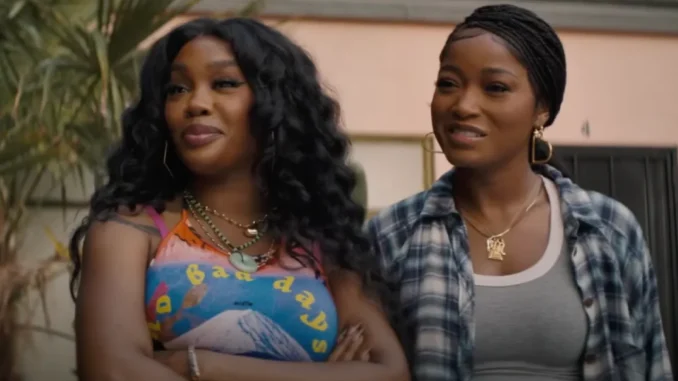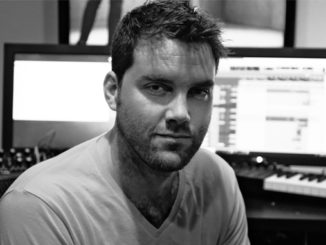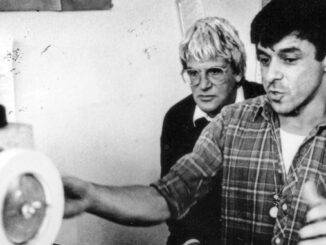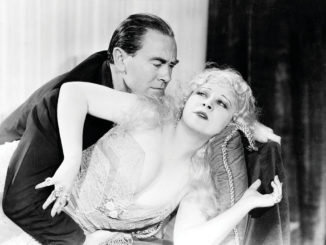
By Peter Tonguette
Picture editor Tia Nolan, ACE, knows comedy.
Nolan was introduced to the craft of cutting comedies under the tutelage of late picture editor Richard Marks, ACE, whom she assisted on James L. Brooks’s “I’ll Do Anything” (1994) and with whom she worked as an associate editor on films on Nora Ephron’s “You’ve Got Mail” (1998) and Mike Nichols’s “What Planet Are You From?” (2000).
As a picture editor, Nolan demonstrated her own dexterity in the genre with her work on such films as Ephron’s “Bewitched” (2005) and Diane English’s “The Women” (2008) as well as numerous films with director Will Gluck, including “Friends with Benefits” (2011), “Annie” (2014), and the 2023 hit “Anyone but You,” starring Sydney Sweeney and Glen Powell.
Nolan knows how to cut a scene around a gag or a punchline, but she also knows that character, more often than not, gives rise to laughs that land.
Authentic, believable, and empathetic characters are at the heart of Nolan’s latest film, director Lawrence Lamont’s sleeper hit “One of Them Days.” The Sony Pictures Releasing feature, which opened to strong box-office numbers on January 17, stars Keke Palmer as Dreux, a dedicated, hard-working young woman in Los Angeles endeavoring to make the leap from waitress to restaurant franchisee. Among the impediments to her best-laid plans is her well-meaning best friend Alyssa (SZA), an artistic-minded, sometimes absent-minded bohemian with whom she shares a too-small apartment—and to whom Dreux has ill-advisedly given the rent money for the present month. As it turns out, the money has been put to other uses by Alyssa’s boyfriend Keshawn (Joshua David Neal).
In the screenplay by Syreeta Singleton, Dreux and Alyssa are given well under 24 hours to find or reconstitute the sum for the rent, evade eviction (promised by their landlord to happen at 6 p.m.), dodge gang members, and, somehow, assure that Dreux’s career path does not hit a road block. At various points, the duo decides to raise funds by donating blood and by fetching a pair of high-priced shoes dangling from a utility pole—resulting in an electrocution and (half of) a financially ruinous ambulance ride.
Nolan attends both to the good-natured friendship between Dreux and Alyssa as well as the urgency of their dilemma; at times, the film resembles a daylight-hours, West Coast version of Martin Scorsese’s “After Hours.” The editing is low-key enough to allow for character moments, and fleet enough to convey their desperate straits.
Nolan shares a co-editing credit with longtime former assistant editor Kim Boritz-Brehm, who edited a number of scenes and praises her mentor’s work and support on the modestly budgeted, tightly scheduled picture. “Having the opportunity to edit scenes on ‘One of Them Days’ was one of the most fun and positive experiences I’ve had,” Boritz-Brehm told CineMontage. “I love working with Tia because we have similar cutting styles and her notes really helped with making the scenes feel super-polished and tight. . . . This film was shot in 21 days, so even though production might not have been able to capture everything on their wish list, we were still able to come together and deliver an entertaining story.”
CineMontage recently spoke with Nolan about “One of Them Days.”
CineMontage: Given your career, do you feel that you have an affinity for comedy?
Tia Nolan: I think being typecast definitely comes into play, because at a certain point you get enough of these credits and then they’re not thinking of you for “The Brutalist.” I’m not on top of that list—not that I couldn’t do it. But yes, definitely my early years were Jim Brooks, Nancy Meyers, and Nora Ephron, of course—these brilliant wordsmiths who were funny and really could take this slice-of-life look. I really, really love that. More than being a comedy editor, I feel like I’m a character editor. There are comedies that are just gimmick-driven, and when you work on comedies, those are really the notes you’re constantly getting: “How do I get it to the next set piece or comedy piece faster?” But I really love to find in the performances, in the story, where those characters live. If you can’t grasp the character, yeah, you might get a laugh, but then you’ll forget about it five minutes later.

CineMontage: How did “One of Them Days” come to you?
Nolan: I have done a lot of movies for Sony, and most recently I did “Anyone but You,” so Sony knew what I can do. This is a much smaller movie. My agent is always in touch with them just to see what’s going on. Last summer, the strikes had decimated the industry, and then no one was greenlighting anything. There wasn’t a ton of stuff coming across anybody’s desk. My agent called me up and he said, “I don’t know if you’re gonna be interested in this—it’s very small, it’s certainly different than what we’ve been looking at for you, but let me send you the script.”
I was not familiar with Lawrence or Syreeta. I had the initial meeting on Zoom with Lawrence, and we have a lot of producers—it was like “Brady Bunch” squares of Zoom, but really it was just Lawrence and I talking. Lawrence’s spirit is so amazing and infectious. He was just super-happy, really excited about the project, and I could tell that this was going to be a fun one—a nice place to be for the next few months.
CineMontage: How did you collaborate with Lawrence?
Nolan: What I do with most directors, and what I did with Lawrence, is I watch the dailies and I then send an email that gives basically an overview of what I’ve seen: positives, any notes, any “Can we grab these shots?” When we shot on film, there used to be the old thing of everybody gathering at the end of the day and screen the dailies. That does not happen anymore, so it’s always a surprise to me if a director has even watched a frame of film before.
I will also edit the scene and immediately send it to the director. We have a secured streaming site. If they have the time to watch it, great. If they don’t, they don’t, but it’s for them to know how the movie’s coming together and to make sure that we’re on the same page. Most of the time, movies just don’t have the schedule to go and start at square one the minute the director is free from production. Lawrence and I were communicating that way and sometimes talking.
CineMontage: How did the tight schedule impact that process?
Nolan: The schedule ended up being a total of 21 days. There were moments, because it was such a tight schedule, where it was just like: “All right, we’re going to have to fix this in post” or “We’re going to have to add visual effects”—whatever it was. Suddenly, the production portion was this crazy train. But it was literally like: “You’re shooting four huge scenes in one day.” They don’t have time, they’re throwing away ideas, they’re compromising here and there and everywhere just to get this stuff shot. Lawrence and I started to talk more, and I was trying to help with solutions to things.
‘I think everybody could use a laugh.’
CineMontage: What sort of workarounds did you suggest when a scene might be shortened or never even shot?
Nolan: One good example of that is the scene in an ambulance after Alyssa has been electrocuted and falls onto Dreux, and Dreux wakes up in the ambulance. That scene, as originally scripted, was supposed to have them jump out of the ambulance while it’s moving. They would have been hanging out the door and the EMTs would have been yelling. It was like an action scene. The studio really loved it, but that is a stunt and expensive. It was a very early thing to get cut out of the script. They shot what you saw, but it lacked the intensity and it lacked that sort of feeling the characters had: “Oh my God, this ambulance is going to cost so much money—we’ve got to get out of here.” At some point, I said, “All right, I’m going to look at this as a horror scene, because it’s a complete horror scene from the minute Dreux wakes up.” I found a horror temp score and used some B-roll to kind of do quick cuts.
CineMontage: And the scene still has a horror-style cue, right?
Nolan: It does. Our amazing composer, Chanda Dancy, did a great job with the music in that scene. The movie was working, but we had a really rough temp score. It was hard to find the tone. Then she came in, and literally every cue she sent us, first draft, was perfect.
CineMontage: What was it like working with Keke Palmer and SZA’s performances?
Nolan: There was this amazing chemistry that just instantly happened with Keke and SZA. They became like best friends instantly, and I could tell because I would watch between takes. They were doing stops and starts in a take to get certain things right, and I saw how they would talk to each other. They were so comfortable instantly, and that shows onscreen. They end up making my job easy.
Keke completely knows her timing, knows all her lines, knows the ad-lib stuff. She will throw jokes in there. She has great energy, and she is just so respectful and kind. SZA is not an actress—now she is certainly—but this is not where she’s coming from. She’s not 100 percent sure all the time in takes where she is and what she’s doing or what she should be doing. She’s just being a version of herself that is so great and free-spirited and charismatic—you can’t take your eyes off of her. Their first scene together was in front of the diner when Alyssa comes and picks up Dreux after work, and they ad-libbed their scene in the car. SZA was holding her own, with Keke in every scene. She was coming up with lines that were so hilariously funny.
CineMontage: How do you sift through that sort of material to make sure the characters still come through and the story still moves forward?
Nolan: It is definitely a challenge because there are times where you’re like, “Oh, I want to use every take.” And with comedy, which I do often, there’s no roadmap. A lot of times with the ad-libs, you find that you get a gem, but you don’t necessarily have the reactions to that gem on the other person’s coverage because they were shot first. You have to actually create moments so that you can build in some of those gems.
I always watch the footage and take notes, and I’m editing the scene as I’m watching the footage. I’m editing in my brain. I get into it, and it’s not always what I thought it was going to be. You might realize, “These two shots that were great performance moments actually do not complement each other, so I’m going to have to rethink this.” On this movie, I was getting four scenes a day, at least, and had no time. I had to find the time to watch blocks of the scenes through so that I could see if the characters were tracking. What was funny in this one scene may be too broad overall for Dreux’s character.
CineMontage: At various spots in the film, title cards pop up announcing how much time is left before Dreux and Alyssa are evicted a 6 p.m. Were those in the script?
Nolan: It was dreamt up along the process. Very early on, I screened the movie for my husband. He said, “This is great. It’s fun to be with the characters, but I’m not feeling the stakes.” And he mentioned things like “High Noon” and “Three O’clock High” where you see some sort of a ticking clock. One day I came in and came up with a graphic where it said it’s this many hours to eviction, but you want to have everybody be able to read it and I didn’t really have the footage. The places I want to put it, I don’t want to cover the action” Then my post supervisor, who was in the room, said, “Well, you can do a freeze-frame.” I was like, “That’s really cheesy,” but then, I did it and it actually worked great. Lawrence came in and I showed him and he said, “This is great.”
CineMontage: Why do you think the movie is resonating with audiences?
Nolan: I think everybody could use a laugh, but I think also at its core it’s about community. It’s about people helping each other even when everything gets horribly hard. It’s just about such a great friendship story—it’s a movie about these two women and how they prop each other up and hold each other up.






